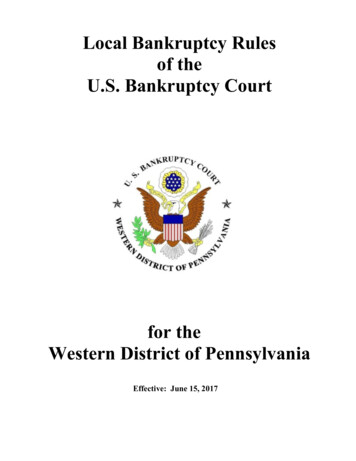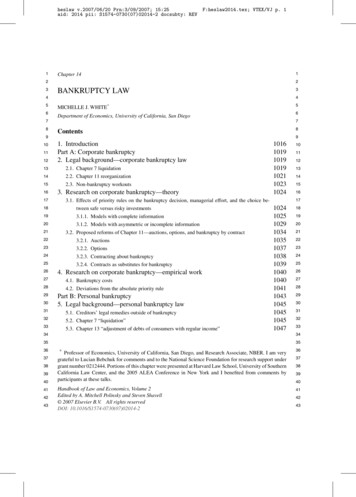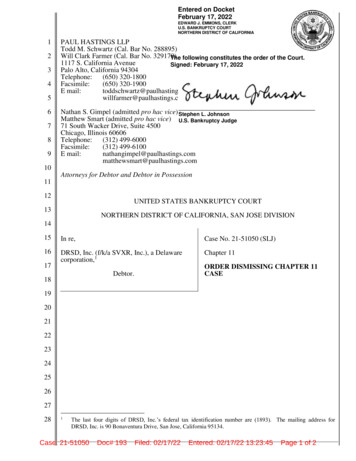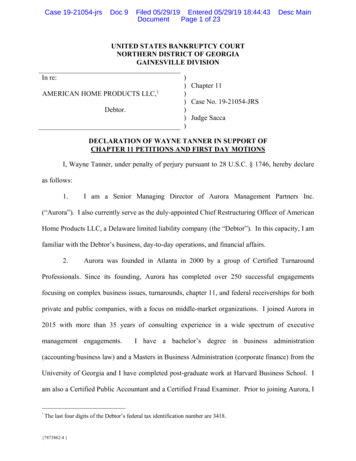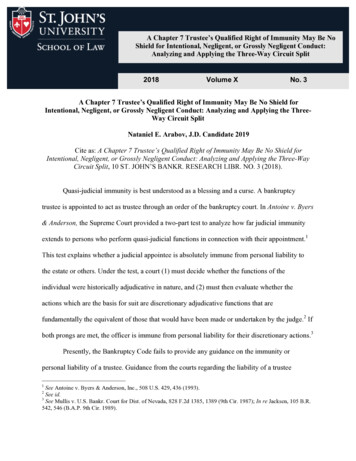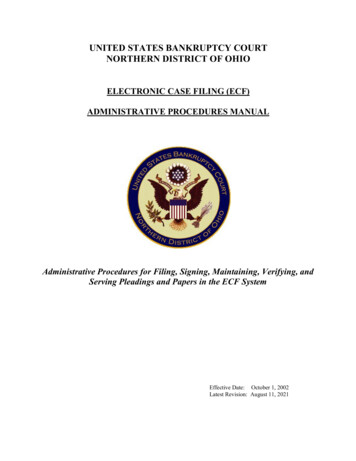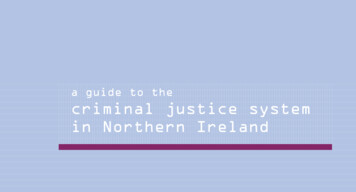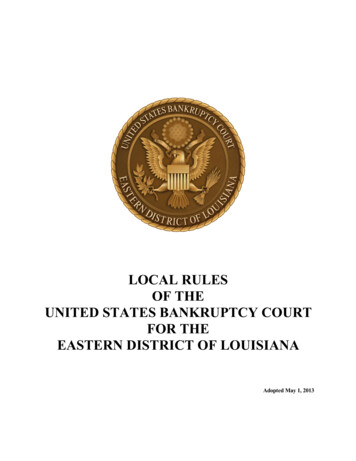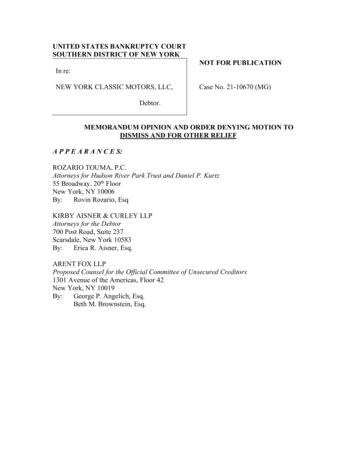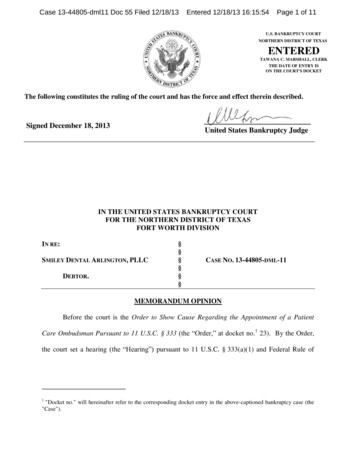
Transcription
Case 13-44805-dml11 Doc 55 Filed 12/18/13Entered 12/18/13 16:15:54Page 1 of 11U.S. BANKRUPTCY COURTNORTHERN DISTRICT OF TEXASENTEREDTAWANA C. MARSHALL, CLERKTHE DATE OF ENTRY ISON THE COURT'S DOCKETThe following constitutes the ruling of the court and has the force and effect therein described.Signed December 18, 2013United States Bankruptcy JudgeIN THE UNITED STATES BANKRUPTCY COURTFOR THE NORTHERN DISTRICT OF TEXASFORT WORTH DIVISIONIN RE:SMILEY DENTAL ARLINGTON, PLLCDEBTOR.§§§§§§CASE NO. 13-44805-DML-11MEMORANDUM OPINIONBefore the court is the Order to Show Cause Regarding the Appointment of a PatientCare Ombudsman Pursuant to 11 U.S.C. § 333 (the “Order,” at docket no.1 23). By the Order,the court set a hearing (the “Hearing”) pursuant to 11 U.S.C. § 333(a)(1) and Federal Rule of1"Docket no." will hereinafter refer to the corresponding docket entry in the above-captioned bankruptcy case (the"Case").
Case 13-44805-dml11 Doc 55 Filed 12/18/13Entered 12/18/13 16:15:54Page 2 of 11Bankruptcy Procedure2 2007.2(a) to consider why a patient care ombudsman should not beappointed in the Case.3At the Hearing on November 26, 2013, the court heard testimony from Lynh Thy PhamDDS, PA (“Pham”), the owner of Smiley Dental Clinics (“Debtors”),4 as well as argument fromDebtors, the U.S. Trustee, and, by and through the office of the Texas Attorney General, theState of Texas and Texas Health and Human Services Commission. No other evidence wasreceived at the Hearing.The court did not appoint a patient care ombudsman at the Hearing, and, after taking thematter under advisement, now issues this memorandum opinion. Having reviewed the pertinentprovisions of the Bankruptcy Code5 and the Rules, as well as the relevant case law and therecord, the court holds that, even assuming that Debtors are health care businesses, a patient careombudsman is not necessary for the protection of patients in the Case.This matter is subject to the court’s core jurisdiction pursuant to 28 U.S.C. §§ 1334(a)and 157(b)(2)(A).This memorandum opinion constitutes the court’s findings of fact andconclusions of law. FED. R. BANKR. P. 7052, 9014.2Hereinafter, “Rule” or “Rules,” as appropriate.3Shortly after the Order was entered, Debtors filed a Motion Pursuant to Bankruptcy Rule 2007.2 to Dispense withPatient Care Ombudsman, docket no. 27, seeking to preempt the appointment of an ombudsman. The State ofTexas and the Texas Health and Human Services Commission filed an untitled brief opposing Debtors’ motion.Docket no. 36. As the Hearing was set on the Order and not Debtors’ motion, the court will treat Debtors’ motionand the response to it as responses by the parties to the Order.4“Debtors” will refer, collectively, to the entities whose bankruptcy cases are being jointly administered with theCase, which include Smiley Dental Arlington, PLLC; Smiley Dental Camp Bowie, PLLC; Smiley Dental Ft. Worth,PLLC; Lynh Thy Pham DDS, PA; J.T. Realty, Inc.; Smiley Dental Asset Management, Inc.; Smiley Dental Beltline,PLLC; Smiley Dental Broadway, PLLC; Smiley Dental Coit, PLLC; Smiley Dental Forest Lane, PLLC; SmileyDental Garland, PLLC; Smiley Dental Gessner, PLLC; Smiley Dental Management Company, LLC; Smiley DentalMesquite, PLLC; Smiley Dental Seminary, PLLC; Smiley Dental Shepherd, PLLC; Smiley Dental Skillman, PLLC;Smiley Dental Walnut, PLLC; Smiley Dental Webb Chapel, PLLC; and Smiley Dental Irving, PLLC. See Mot. forJoint Administration, docket no. 2.511 U.S.C. §§ 101 et seq. (2006) (the “Code”).MEMORANDUM OPINIONPAGE 2 OF 11
Case 13-44805-dml11 Doc 55 Filed 12/18/13Entered 12/18/13 16:15:54Page 3 of 11I. BACKGROUNDDebtors operate nineteen dental clinics that provide general dental services, as well asoral surgery and orthodontic care. At one time, Debtors and affiliates operated as many as thirtythree such clinics. But, according to Pham’s testimony, changes in Medicaid reimbursements fororthodontic services resulted reduced cash flow and profitability. As a result, fourteen clinicswere closed prepetition, and, on October 23, 2013, Debtors filed voluntary petitions underchapter 11 of the Code for the remaining nineteen clinics. Pham testified that the bankruptcyfilings were caused by the reduction in profitability and not as a result of patient care issues orany malpractice claims.Debtors employ over 100 people, including a number of contract dentists. Pham testifiedthat Debtors’ dentists are all current with their required licenses and covered by adequateinsurance. The dentists work in teams to provide oversight and to ensure quality care. Some ofDebtors’ dentists perform oral surgeries, such as root canals, beyond basic dental cleanings andfillings. Likewise, the dentists provide diagnostic care for various periodontal diseases, but willrefer a patient to a specialist for any treatment beyond the dentists’ level of expertise. Debtors’clinics do not provide after-hours or overnight care, and the clinics direct patients to call 911 for“life or death” matters.Some of Debtors’ clinics maintain digital medical records stored on a computer database,while other clinics have paper records. Pham testified that these paper records are protected atDebtors’ clinics and that patients have access to these records upon request.II. DISCUSSIONCongress added several provisions to the Code in 2005 that were intended to protectpatients’ interests in bankruptcies involving health care businesses by mandating that the courtappoint a patient care ombudsman or “patient advocate.” See Bankruptcy Abuse Prevention andMEMORANDUM OPINIONPAGE 3 OF 11
Case 13-44805-dml11 Doc 55 Filed 12/18/13Entered 12/18/13 16:15:54Page 4 of 11Consumer Protection Act, Pub. L. No. 109–8, § 1101(a)(2) (2005), reprinted in 2005U.S.C.C.A.N. (119 Stat.) 23, 189 (codified at 11 U.S.C. § 333). Section 333 of the Codeprovides:If the debtor in a case under chapter 7, 9, or 11 is a health care business, the courtshall order, not later than 30 days after the commencement of the case, theappointment of an ombudsman to monitor the quality of patient care and torepresent the interests of the patients of the health care business unless the courtfinds that the appointment of such ombudsman is not necessary for the protectionof patients under the specific facts of the case.11 U.S.C. § 333(a)(1) (2006). Such appointment is limited to debtors operating a “health carebusiness.” Id. Section 101(27A) defines the term “health care business” as:(27A) The term “health care business”—(A) means any public or private entity (without regard to whether that entity isorganized for profit or not for profit) that is primarily engaged in offering tothe general public facilities and services for—(i) the diagnosis or treatment of injury, deformity, or disease; and(ii) surgical, drug treatment, psychiatric, or obstetric care; and(B) includes—(i) any—(I) general or specialized hospital;(II) ancillary ambulatory, emergency, or surgical treatment facility;(III) hospice;(IV) home health agency; and(V) other health care institution that is similar to an entity referred toin subclause (I), (II), (III), or (IV); and(ii) any long-term care facility, including any—(I) skilled nursing facility;(II) intermediate care facility;(III) assisted living facility;(IV) home for the aged;(V) domiciliary care facility; and(VI) health care institution that is related to a facility referred to insubclause (I), (II), (III), (IV), or (V), if that institution is primarilyengaged in offering room, board, laundry, or personal assistance withactivities of daily living and incidentals to activities of daily living.Id. § 101(27A).As Code sections 101(27A) and 333 and the corresponding Rules are relatively recentadditions, little authority is available to guide the application of these provisions. Nonetheless,MEMORANDUM OPINIONPAGE 4 OF 11
Case 13-44805-dml11 Doc 55 Filed 12/18/13Entered 12/18/13 16:15:54Page 5 of 11the mechanics of the provisions are relatively straightforward based on the plain meaning of thestatute. See United States v. Ron Pair Enters., Inc., 489 U.S. 235, 242 (1989) (“The plainmeaning of legislation should be conclusive, except in the ‘rare cases [in which] the literalapplication of a statute will produce a result demonstrably at odds with the intentions of itsdrafters.’”) (quoting Griffin v. Oceanic Contractors, Inc., 458 U.S. 564, 571 (1982)). Pursuant tothe language in the Code and the Rules, the court must appoint a patient care ombudsman unless(1) the debtor does not qualify as a health care business under section 101(27A) or (2) the courtfinds that the appointment is not necessary for the protection of patients under the specific factsof the case. 11 U.S.C. §§ 101(27A), 333(a)(1); In re William L. Saber, M.D., P.C., 369 B.R.631, 634 (Bankr. D. Colo. 2007). The court will address each of these issues in turn.A. Qualification as a Health Care Business Under Section 101(27A)A plain reading of section 101(27A) requires the existence of four elements for a debtorto qualify as a health care business. In re Med. Assocs. of Pinellas, L.L.C., 360 B.R. 356, 350(Bankr. M.D. Fla. 2007). Specifically, (1) the debtor must be a public or private entity; (2) thedebtor must be primarily engaged in offering to the general public facilities and services; (3) thedebtor’s facilities and services must be offered to the public for the diagnosis or treatment ofinjury, deformity, or disease; and (4) the debtor’s facilities and services must be offered to thepublic for surgical care, drug treatment, psychiatric care, or obstetric care. Id. The first element“includes almost every conceivable entity,” so the inquiry typically focuses on the last threeelements. Id. at 359. The second element turns on whether a debtor is open to the general publicdirectly, is accessible only by the referral of another physician, or is not at all accessible bypatients themselves.Compare In re Saber, 369 B.R. at 636 (doctor offering plastic andreconstructive surgery to the general public at his medical office or at an area hospital satisfiedthe second element), with In re 7-Hills Radiology, 350 B.R. at 904 (radiology clinic providingMEMORANDUM OPINIONPAGE 5 OF 11
Case 13-44805-dml11 Doc 55 Filed 12/18/13Entered 12/18/13 16:15:54Page 6 of 11tests to patients only upon referral by a treating physician did “not offer anything to the generalpublic”), and In re Med. Assocs., 360 B.R. at 359–60 (debtor was not engaged in offeringfacilities and services to general public when primarily providing administrative support todoctors for billing, insurance, human resources, and related financial services). Additionally, theinclusion of “drug treatment” in the fourth element likely references “facilities that treat drugaddiction or dependency . . . [rather than] the writing or dispensing of prescriptions (which couldinclude all doctors and pharmacies).” In re Med. Assocs., 360 B.R. at 360 n.3.While these elements are contained in subsection (A) of section 101(27A), subsection (B)provides two non-exhaustive example lists of health care businesses.11 U.S.C.§ 101(27A)(B)(i)–(ii). Each list concludes with a catchall provision referencing comparableentities to those listed in the respective list. Id. § 101(27A)(B)(i)(V), (ii)(VI).The few cases that have interpreted section 101(27A)(A)–(B) have not done souniformly. One line of cases has read subsections (A) and (B) as described above—that is,subsection (A) provides elements and subsection (B) provides examples. See In re StarmarkClinics, LP, 388 B.R. 729, 734 (Bankr. S.D. Tex. 2008); In re Alternate Family Care, 377 B.R.754, 757 (Bankr. S.D. Fla. 2007); see also In re Med. Assocs., 360 B.R. at 350. On the otherhand, another line of cases has focused on Congress’s use of the conjunctive “and” to connectsubsections (A) and (B). In re Saber, 369 B.R. at 636; In re Anne C. Banes, D.D.S. P.L.L.C.,355 B.R. 532, 534–35 (Bankr. M.D.N.C. 2006); see also In re 7-Hills Radiology, LLC, 350 B.R.902, 905 (Bankr. D. Nev. 2006). This second line of cases concludes that, by connecting the twostatutes with the conjunctive “and” instead of the disjunctive “or,” Congress intended that “adebtor . . . must meet every requirement under both subsections for a patient ombudsman to beappointed.” In re Saber, 369 B.R. at 636 (citing In re Banes, 355 B.R. at 534) (emphasis added).MEMORANDUM OPINIONPAGE 6 OF 11
Case 13-44805-dml11 Doc 55 Filed 12/18/13Entered 12/18/13 16:15:54Page 7 of 11As a result, these cases engraft a fifth element onto the section 101(27A) analysis, requiring thata debtor’s business involve “‘direct and ongoing contact with patients’ that provide[s] patientswith ‘shelter and sustenance in addition to medical treatment.’” In re Banes, 355 B.R. at 535(quoting In re 7-Hills Radiology, 350 B.R. at 904).Based on a plain reading of section 101(27A)(A), Debtors likely qualify as health carebusinesses. Debtors’ businesses are private entities within the ambit of the first element. Basedon Pham’s testimony at the Hearing, Debtors also satisfy the other three required elements.Debtors offer various dental and orthodontic services at the clinics, all of which are openlyadvertised to the general public, including through a publicly available website. See In reAlternate Family Care, 377 B.R. at 757 (“[T]he very presence of the website suggests [thedebtor] has a public presence and . . . it is plausible to suggest that it is offering its services to thegeneral public.”). In addition to general dentistry functions, such as annual cleanings and x-rays,Debtors’ orthodontic practices focus on diagnosing and treating orthodontic deformities, and thearray of available services includes various surgical procedures, such as root canals and theremoval of wisdom teeth.6Accordingly, Debtors’ businesses likely qualify as health carebusinesses under the four-element test in section 101(27A)(A).At the Hearing, Debtors and the U.S. Trustee advocated that the court should follow thesecond line of cases applying section 101(27A) and read into the statute an element of direct andongoing contact with patients while providing shelter and sustenance.By comparing thesimilarities of the entities listed in subparagraph (B) of section 101(27A), this second line of6Pham’s testimony about Debtors’ services is confirmed by Debtors’ website that, in addition to general dentistryservices, advertises preventative and diagnostic services for periodontal disease, orthodontics, and oral surgeries forwisdom teeth and tooth extractions. SMILEY DENTAL & ORTHODONTICS, http://smileydental.net/ (last visited Dec. 3,2013); see also In re Alternate Family Care, 377 B.R. at 756–58 (relying upon the debtor’s website whiledetermining whether debtor qualified under section 101(27A)).MEMORANDUM OPINIONPAGE 7 OF 11
Case 13-44805-dml11 Doc 55 Filed 12/18/13Entered 12/18/13 16:15:54Page 8 of 11cases has created an inpatient treatment requirement for health care businesses. See In re Banes,355 B.R. at 535 (“[T]he types of businesses listed are all of such a similar nature in that theyprovide both housing and treatment . . . that it is difficult to imagine that the legislature wouldhave intended a business that is so fundamentally different, such as an outpatient dental practice,to be read into the definition.”).Requiring this judicially created element, which does not appear in section 101(27A),misconstrues the statute. The language in section 101(27A)(B) is inclusive of the specificentities listed and other similar entities, but not exclusive of other business entities meeting thetest under section 101(27A)(A). See 11 U.S.C. § 102(3) (“In this title . . . ‘includes’ and‘including’ are not limiting.”); see also In re Med. Assocs., 360 B.R. at 360–61 (“Each of theexamples in subparagraph (B) of section 101(27A) . . . clearly includes long-term care healthfacilities, such as hospitals and nursing homes. Arguably, the definition could include walk-inclinics where patients stay for short durations.”). Other courts have found that businessesproviding only outpatient services prepetition may qualify as health care businesses. See, e.g., Inre Genesis Hospice Care LLC, No. 08–15576, 2009 WL 467265, at *1–2 (Bankr. N.D. Miss.2009) (debtor provided only outpatient medical care to patients in their homes or nursinghomes); In re RAD/ONE, P.A., No. 08–15517, 2009 WL 467286, at *1 (Bankr. N.D. Miss. 2009)(debtor provided only outpatient radiological services); In re N. Shore Hematology-OncologyAssocs., P.C., 400 B.R. 7, 9, 12 (Bankr. E.D.N.Y. 2008) (debtor's health care practice providingservices in areas of cancer treatment and blood disorders did not provide any in-patient services).Even if both subsection (A) and (B) must be met under section 101(27A), Debtors stilllikely qualify as health care businesses. In In re Saber, the court held that a plastic surgeon whoperformed “minor surgeries with local anesthesia” in his office qualified as a “surgical treatmentMEMORANDUM OPINIONPAGE 8 OF 11
Case 13-44805-dml11 Doc 55 Filed 12/18/13Entered 12/18/13 16:15:54Page 9 of 11facility” under section 101(27A)(B)(i)(II). 369 B.R. at 637. Because “the statute does notdifferentiate between minor and major surgeries[,]” the debtor fell within the example list insubparagraph (B) and thus was a “health care business” within the meaning of section 101(27A).Id. The same analysis applies here because Debtors perform various surgeries—such as rootcanals, wisdom tooth removal, and tooth extractions—and likewise fall within the enumeratedentities in subparagraph (B). See 11 U.S.C. § 101(27A)(B)(i)(II). As a result, Debtors wouldlikely qualify as health care businesses under the more stringent test articulated by the secondline of cases. See In re Saber, 369 B.R. at 636; In re Banes, 355 B.R. at 534–35.However, while the plain meaning of section 101(27A) would likely characterize Debtorsas health care businesses, the court need not decide that issue. The patient care ombudsmananalysis is not lock-step, so the court is not bound to decide first whether Debtors are health carebusinesses under section 101(27A) and then turn to section 333(a)(1). Instead, a court mayassume that section 101(27A) has been met for the purpose of analyzing section 333(a)(1). SeeIn re Vartanian, No. 07–10790, 2007 WL 4418163, at *2 (Bankr. D. Vt. Dec. 13, 2007) (holdingthat factors weighed against appointing ombudsman even assuming that the debtor qualified as ahealth care business); In re Banes, 355 B.R. at 532 (same); In re Total Woman Healthcare Ctr.,P.C., No. 06–52000, 2006 WL 3708164, at *3 (Bankr. M.D. Ga. 2006) (holding that no analysisof section 101(27A) was necessary because no ombudsman was required). Even assuming thatDebtors qualify as health care businesses, the court holds that the appointment of an ombudsmanis not necessary for the protection of patients under the specific facts of the Case.B. Appointment of a Patient Care Ombudsman Under Section 333(a)(1)Section 333(a)(1) makes the appointment of a patient care ombudsman mandatory“unless the court finds that the appointment of such ombudsman is not necessary for theprotection of patients.” 11 U.S.C. § 333(a)(1). This inquiry is on a prospective basis, “indicatingMEMORANDUM OPINIONPAGE 9 OF 11
Case 13-44805-dml11 Doc 55 Filed 12/18/13Entered 12/18/13 16:15:54Page 10 of 11that [Congress] was concerned with appointing patient care ombudsman in cases where healthcare businesses seeking bankruptcy protection are currently engaged in the ongoing care ofpatients.” In re Banes, 355 B.R. at 535.The exception to the mandatory appointment affords a court considerable discretion toweigh the facts of each case when determining whether an ombudsman is required. In re ValleyHealth Sys., 381 B.R. 756, 761 (Bankr. C.D. Cal. 2008). The party opposing the appointment ofthe ombudsman bears the burden of overcoming the mandatory appointment. In re StarmarkClinics, 388 B.R. at 734. In determining whether this burden has been satisfied, courts haveapplied a nine-factor test, first announced in In re Alternate Family Care. 377 B.R. at 758.These factors include:(1) the cause of the bankruptcy; (2) the presence and role of licensing orsupervising entities; (3) debtor’s past history of patient care; (4) the ability of thepatients to protect their rights; (5) the level of dependency of the patients on thefacility; (6) the likelihood of tension between the interest of the patients and thedebtor; (7) the potential injury to the patients if the debtor drastically reduced itslevel of patient care; (8) the presence and sufficiency of internal safeguards toensure appropriate level of care; [and] (9) the impact of the cost of an ombudsmanon the likelihood of a successful reorganization.Id. Some additional factors courts have considered include:[1 that] the facility’s patient care is of high quality, [2] that the debtor hasadequate financial strength to maintain high-quality patient care, [3] that thefacility already has an internal ombudsman program in operation or [4] that thesituation at the facility is adequately monitored by federal, state, local orprofessional association programs so that the ombudsman would be redundant.3 COLLIERONBANKRUPTCY ¶ 333.02[2] (Alan N. Resnick & Henry J. Sommer eds., 16th ed.2012).Here, Debtors have carried the burden of opposing the mandatory appointment. Based onthe evidence presented at the Hearing, Debtors’ bankruptcy filings appear to have been causedby a cash flow problem resulting from changes to Medicare reimbursement practices forMEMORANDUM OPINIONPAGE 10 OF 11
Case 13-44805-dml11 Doc 55 Filed 12/18/13Entered 12/18/13 16:15:54Page 11 of 11orthodontics. Debtors’ businesses require licenses and insurance coverage, all of which wererepresented to be current and in accord with state requirements. Pham testified that Debtorscurrently maintain a mix of electronic and paper medical records for patients and that the papermedical records are adequately protected. No evidence was presented at the Hearing regardingpast issues of patient care. Rather, the evidence shows that patients have access to their medicalrecords and, generally, a low level of provider dependency. Both of these factors enable apatient, should he or she choose, to seek alternate dental or orthodontic care.Becausemalpractice does not appear to have caused the bankruptcy, no likelihood of tension between theinterests of the patients and Debtors appears to exist. Finally, Pham testified that Debtors’doctors work in teams, which provides a form of internal oversight and safeguard for patientcare. Based on the evidence presented at the Hearing, the court finds that Debtors have carriedthe required burden and that the totality of the circumstances weighs against the appointment of apatient care ombudsman at this time.III. CONCLUSIONFor the foregoing reasons, the court discharges the Order and declines to appoint a patientcare ombudsman at this time. But the protection of patients during bankruptcies that involvehealth care businesses—assuming Debtors so qualify—is an ongoing concern. Accordingly, thecourt’s discharge of the Order regarding the appointment of an ombudsman is without prejudiceto a future motion by the U.S. Trustee or a party in interest for such an appointment. FED. R.BANKR. P. 2007.2(b).It is so ORDERED.### END OF MEMORANDUM OPINION ###MEMORANDUM OPINIONPAGE 11 OF 11
IN THE UNITED STATES BANKRUPTCY COURT FOR THE NORTHERN DISTRICT OF TEXAS FORT WORTH DIVISION IN RE: § SMILEY DENTAL ARLINGTON, PLLC § CASE NO. 13-44805-DML-11 DEBTOR. MEMORANDUM OPINION Before the court is the Order to Show Cause Regarding the Appointment of a Patient Care Ombudsman Pursuant to 11 U.S.C. § 333 (the "Order," at docket no.1 23).

